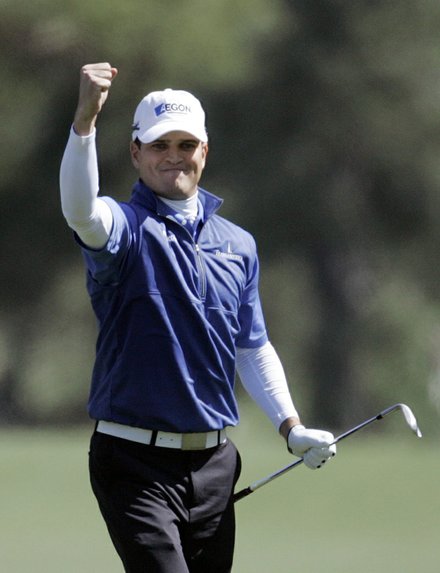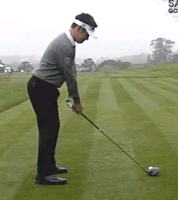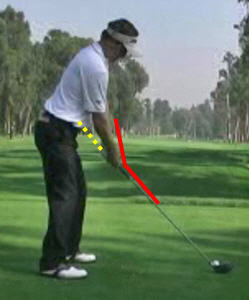For this game you need, above all things, to be in a tranquil frame of mind.
- Harry Vardon, 6 time British Open Champion & 1 time US Open Champion
My mind is my biggest asset. I expect to win every tournament I play.
-Tiger Woods, 14 time Major Champion & held each major trophy in his "Tiger Slam"
Competitive golf is played mainly on a five-and-a-half-inch course, the space between your ears.
-Bobby Jones, 7 time Major Champion & winner of all 4 majors in one calendar year (the "Grand Slam")
The Mental Game:
The mental part of golf becomes much more prominent once you have the basics down and can become a competitive golfer. As in life, in golf you will get some good bounces and some bad ones, some good days and some bad days, but all in all if you keep a level head and focus on having fun everything will work out in the end. Truly the mental game can be that simple, it's not life or death, it's just a game.
I have learned much of these ideas from sports psychologists Dr. Bob Rotella and Dr. Joseph Parent (I strongly recommend their books if you can get a hold of them). The great thing about their "philosophies" is that their ideas are pretty much common sense, however we tend to forget them.
In this section I'll highlight the main points that I've learned from my experiences and from the above mentioned authors.
Golfing Philosophy: "There is no such thing as "muscle memory." Your muscles have no capacity to remember anything. Memory resides in your head. Therefore no matter how long you practice a golf swing, no matter how skilled you become at it, your muscles alone can't remember it and execute it when the need arises on the golf course. Your muscles and the rest of your body are controlled by your mind. Unless your mind is functioning well when you play golf, your muscles are going to flounder. If your head is filled with bad shots, your scorecard is going to be full of bad strokes" (Rotella 2).
"The keys to preparation are clarity, commitment, and composure. These are necessary for developing a sound, consistent routine. The ideal state of mind for action is feeling confident, focused, and in the flow, with body and mind synchronized in the present moment. This allows you to execute a shot free from the interference of mental chatter or paralysis from analysis. The best response to results is one that enhances future performance" (Parent xvii-xviii).
Thinking outside of the box:
To complete the Nine Dots Exercise (where you connect nine dots with only 3 or 4 straight lines without lifting your pencil from the paper) you need to go outside the artificial limits of the 'box' that the nine dots seem to define. If you assume you have to stay within the box, four continuous straight lines will always leave at least one dot unconnected. You have to think outside the box. The point of this exercise is to show how we limit ourselves by our assumptions. Looking at things with a big mind, with a larger or different perspective, increases our choices dramatically. It allows for so much more creativity. Sometimes aiming for the rough is the better play than playing down the water lined fairway, sometimes aiming for the slope at the back of the green will be a much more easier way to get the ball closer to the pin. When uncomfortable with your long irons and you face a shot with hazards surrounding the green, instead of going for the green, take a page out of Zach Johnson's book from the 2007 Masters, where he laid up on every par 5 that week and went on to win.

Par for the course: "'Par' is an example of an illusory 'box' that mid- to high-handicap golfers create for themselves. They would do well to think outside of it. Less than 1 percent of all golfers have completed a round of golf in par or better. That makes it a rather unrealistic target score for all but the most skilled among us. Measuring yourself against the par on the scorecard is a setup for failure for the average golfer [...] when it was first used, the number set as 'par for the course' varied according to the difficulty of the course under conditions under which a competition was played. If it was played in a howling wind and driving rain on a long, tight golf course, par might have been set at 85 that day. A scorecard on the other hand doesn't change with the weather. I suggest that you set your own par for the course. Change the par written on the scorecard to reflect your handicap, as well as the conditions, making it your 'personal par for the day.' Before each round, on your scorecard, cross out and rewrite the par given to each of the harder holes on the course. Add one for as many holes as you receive handicap strokes (and one or two more if the weather or course conditions are extra challenging). The harder par-4 holes are now par-5s, etc. For high handicappers (over 18), on some holes your 'personal par' will be two strokes higher than the par on the scorecard. You will become much more at ease approaching a difficult hole from this new perspective. It will also encourage more patience in recovering from a mis-hit, knowing you have that extra stroke or two to get to the green. You'll also feel much better at the end of a hole or the end of a round by using this perspective-changing technique. For a 20-handicapper playing the hardest hole, instead of dejectedly saying, 'I made another double-bogey,' you get to say, 'I made my par!' at the end of your round, instead of saying, 'I shot a ninety-one,' you get to say, 'I finished at one under par!' It's pretty clear which will make you feel more encouraged about this round and more confident about the next one. The idea of reaching the par on the scorecard seems an insurmountable task when it is twenty strokes away. Getting there little by little with rewards along the way is much more workable" (Parent 10-12).
Complaining: "when things aren't the way we'd like them to be, there's a tendency to complain. This is certainly true for golfers. 'It's windy.' it's cold. 'The greens are too bumpy.' 'The rough is too deep.' 'The fairways are too narrow.' 'There aren't enough parking spaces.' And on and on. Jack Nicklaus said that at many tournaments he felt he only had to beat a few of his fellow competitors. When he'd hear players complain about conditions, he'd check them off one by one, thinking to himself, 'there's a guy who won't be in contention.' 'There's another one I don't have to worry about.' By the time the tournament started, not many were left. Instead of complaining, recognize that everyone has to play the same course. Golf and life aren't fair on a day-to-day basis. But those good and bad breaks even out over the long run. Learn to play a variety of conditions. Adapt yourself and your state of mind to whatever you encounter. Don't complain about anything, not even to yourself." Note that we don't get rid of our suffering attitude and feelings of deflation by acting out our anger or throwing a tantrum. The very effort of "getting rid" of our suffering is just another kind of suffering. So just put the club back in the bag and breathe deeply, smile and give a thumbs up to your playing partners, enjoying the opportunity to play this wonderful game!
"The keys to preparation are clarity, commitment, and composure. These are necessary for developing a sound, consistent routine. The ideal state of mind for action is feeling confident, focused, and in the flow, with body and mind synchronized in the present moment. This allows you to execute a shot free from the interference of mental chatter or paralysis from analysis. The best response to results is one that enhances future performance" (Parent xvii-xviii).
Thinking outside of the box:
To complete the Nine Dots Exercise (where you connect nine dots with only 3 or 4 straight lines without lifting your pencil from the paper) you need to go outside the artificial limits of the 'box' that the nine dots seem to define. If you assume you have to stay within the box, four continuous straight lines will always leave at least one dot unconnected. You have to think outside the box. The point of this exercise is to show how we limit ourselves by our assumptions. Looking at things with a big mind, with a larger or different perspective, increases our choices dramatically. It allows for so much more creativity. Sometimes aiming for the rough is the better play than playing down the water lined fairway, sometimes aiming for the slope at the back of the green will be a much more easier way to get the ball closer to the pin. When uncomfortable with your long irons and you face a shot with hazards surrounding the green, instead of going for the green, take a page out of Zach Johnson's book from the 2007 Masters, where he laid up on every par 5 that week and went on to win.

Par for the course: "'Par' is an example of an illusory 'box' that mid- to high-handicap golfers create for themselves. They would do well to think outside of it. Less than 1 percent of all golfers have completed a round of golf in par or better. That makes it a rather unrealistic target score for all but the most skilled among us. Measuring yourself against the par on the scorecard is a setup for failure for the average golfer [...] when it was first used, the number set as 'par for the course' varied according to the difficulty of the course under conditions under which a competition was played. If it was played in a howling wind and driving rain on a long, tight golf course, par might have been set at 85 that day. A scorecard on the other hand doesn't change with the weather. I suggest that you set your own par for the course. Change the par written on the scorecard to reflect your handicap, as well as the conditions, making it your 'personal par for the day.' Before each round, on your scorecard, cross out and rewrite the par given to each of the harder holes on the course. Add one for as many holes as you receive handicap strokes (and one or two more if the weather or course conditions are extra challenging). The harder par-4 holes are now par-5s, etc. For high handicappers (over 18), on some holes your 'personal par' will be two strokes higher than the par on the scorecard. You will become much more at ease approaching a difficult hole from this new perspective. It will also encourage more patience in recovering from a mis-hit, knowing you have that extra stroke or two to get to the green. You'll also feel much better at the end of a hole or the end of a round by using this perspective-changing technique. For a 20-handicapper playing the hardest hole, instead of dejectedly saying, 'I made another double-bogey,' you get to say, 'I made my par!' at the end of your round, instead of saying, 'I shot a ninety-one,' you get to say, 'I finished at one under par!' It's pretty clear which will make you feel more encouraged about this round and more confident about the next one. The idea of reaching the par on the scorecard seems an insurmountable task when it is twenty strokes away. Getting there little by little with rewards along the way is much more workable" (Parent 10-12).
Complaining: "when things aren't the way we'd like them to be, there's a tendency to complain. This is certainly true for golfers. 'It's windy.' it's cold. 'The greens are too bumpy.' 'The rough is too deep.' 'The fairways are too narrow.' 'There aren't enough parking spaces.' And on and on. Jack Nicklaus said that at many tournaments he felt he only had to beat a few of his fellow competitors. When he'd hear players complain about conditions, he'd check them off one by one, thinking to himself, 'there's a guy who won't be in contention.' 'There's another one I don't have to worry about.' By the time the tournament started, not many were left. Instead of complaining, recognize that everyone has to play the same course. Golf and life aren't fair on a day-to-day basis. But those good and bad breaks even out over the long run. Learn to play a variety of conditions. Adapt yourself and your state of mind to whatever you encounter. Don't complain about anything, not even to yourself." Note that we don't get rid of our suffering attitude and feelings of deflation by acting out our anger or throwing a tantrum. The very effort of "getting rid" of our suffering is just another kind of suffering. So just put the club back in the bag and breathe deeply, smile and give a thumbs up to your playing partners, enjoying the opportunity to play this wonderful game!
Take a Bigger View of Control: "The mind is like a high-spirited wild horse. If you try to control it by locking it up, it will be agitated and restless. If you try to force it to be still, it will kick and fight even more. Take a bigger view of control. Within the big meadow of awareness, let the wild horse of your mind run her and there. With nothing to struggle against, it will eventually settle down on its own. When it has settled, you can tame it, when it is tame, you can train it. Then you can ride the horse of your mind, and it will swiftly take you wherever you want to go" (Parent 18). We have the option to berate and get angry at ourselves or the slow play that's "ruining our round," or we can choose to laugh off the bad shot and invent some games to have fun while waiting for the group in front of you.
Mindful Breathing: Arguably the most dangerous and destructive mental error in golf (and life for that matter) is being caught in the past, lost in the past, or enslaved in the past, as is being caught in the future, lost in the future, or enslaved by the future. Of course one cannot discount the past or future for planning your strategies, however, standing over the ball telling yourself "don't hit it in the water like I did here last time" or "all I have to do is par the last four to beat my personal best score" 100% of the time leads to an uncommitted, tenative swing that will in all likelihood end up in terrible results. No one can ever stop these thoughts from entering our mind because it is human nature, however you can make it a habit to take mindful breaths in the times when your conscious doesn't seem to want to shut up!
With the inhalation, silently say, "I am aware of my breath" and with exhalation silently say, "I am aware of my outbreath." It's truly quite simple, yet quite effective. Mindful breathing allows for confusion concerning future events, questions, doubts, and the resulting anxiety to fade away, thus allowing us to be aware of the present moment. Take in the waft of the breeze, feel the softness of the grass under your feet, and see the beauty of the clouds. Think of it like the Orca who must come up to the surface to breathe.
Paralysis by Analysis: Everyone who has played this game long enough has had that overwhelming feeling mid-round where you know that something in your swing is off and you have "a million" swing thoughts running through your mind in order to fix it. Unfortunately while our intentions to play better are in the act of consciously trying different moves to fix that pesky slice, the golf course is not a suitable place to try those different moves. On the golf course, it's best to let go of the frustration with mindful breathing and the faith in your abilities to fix your swing once the round is done.
Having the mindset, that yes I'm not playing how I want to, but I'll just carry on and have fun right now is a great mindset to have, because you know what you never know what the rest of the round will be like. Who can say that they had a bad day golfing when you had one or more of the following: a hole-in-one, a chip in, a double eagle, a long putt, a holed bunker shot, a holed flop shot, a "Phil Mickelson" punch shot threaded through the trees, a good laugh with friends or playing partners, an unbelievably lucky shot, a holed fairway shot, a perfectly played draw or fade to the green, a successful opposite handed shot, a shot off the flagstick, a putt that rounds the cup and laughably falls in, your best 9 hole score, your best streak of birdies/ holes without a bogey, a great recovery shot from a terrible lie, a shot that you've never tried before...
...add to the list what you like, you can always find a way to turn a "bad" day into a a fun enjoyable one!!!
Rotella, Bob. The Golfer's Mind: Play To Play Great. Free Press; Tour Player Edition edition (November 16, 2004)
Parent, Joseph. Zen Golf: Mastering the Mental Game. Doubleday; 1st edition (May 14, 2002)




















































